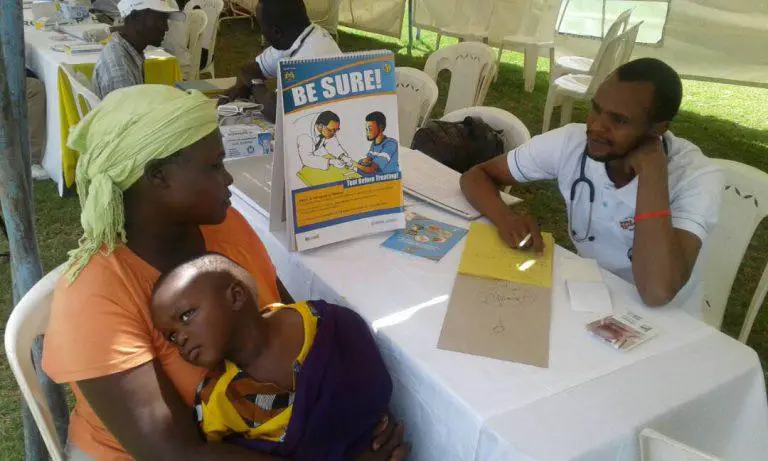Tuberculosis and Malaria have been a thorn in the flesh of the country’s health sector.
This is why Amref Health Africa in Kenya has signed a Global Fund Tuberculosis and Malaria grant of Ksh 7.6 billion ($70,416,010).
The fund will be split into two portions: towards control of TB a total of (KES 5.6 billion) ($51,875,868) has been set aside, and to control Malaria (KES 1.8 billion) ($16,674,386) has been earmarked.
According to information from Amref, this is a 3-year project that is set to be implemented between the year 2021 and 2024 with the help of implementing partners.
Kenya’s ministry of health says that TB remains a global and national public health concern. Globally, 104 million people are infected with TB of which nearly 1.5 million die each year. In Kenya, TB is the fifth leading cause of death. In 2019, Kenya reported and treated 86,504 cases of TB of which approximately 10% are children. Drug-resistant TB cases have been on the rise with 688 such cases in the country as of 2019.
Also Read: African Swine Fever outbreak reported in Heilbron, Free State
In Kenya, there are an estimated 3.5 million new clinical cases of Malaria and 10,700 deaths each year. Kenyans living in western part of the country are particularly at the risk of the disease.
This grant therefore, will support initiatives to find missing people with TB, ensuring patients on TB treatment adhere to medication, community case management of Malaria and mitigating the impact of COVID-19 on HIV, Tuberculosis and Malaria. Amref says it will implement these key national interventions through sub-recipients, civil society organizations private providers and community volunteers.
In 2018, kenya was a mong the three countries selected alongside Ghana and Malawi to take part in the World Health Organization – led pilot programme for the RTS,S/AS01 malaria vaccine.
In 2017, the Ministry of Health distributed a total of 14.8 million treated bed nets to communities across 23 malaria endemic and epidemic prone counties providing protection to 25 million people. The Ministry in collaboration with partners is also implementing other malaria control interventions, which include the Indoor Residual Spraying (IRS) in Migori and Homabay with plans to expand this to Kisumu from 2019.
Kenya also adopted universal coverage with prevention measures as a key strategy through the use of Long Lasting Insecticidal Nets (LLIN). So far the government has distributed 16 million LLINs in 36 counties. Currently 63% of households own at least one LLIN, an improvement from 44% in 2010 which shows an increase from 61% to 71% over the last five years. Currently, more than 87 per cent of health facilities have the capacity to diagnose malaria. Through capacity- building mentorship and supervision, 97 per cent of all confirmed malaria cases received the recommended medicine. World Health Organisation estimates that more than 500,000 African lives are lost to malaria every year.
Amref has therefore pledged to work with the support of Global Fund and Kenya Coordinating Mechanism (KCM), The National Treasury and the National TB and Malaria programs, stakeholders, sub-recipients and communities to enable a seamless service delivery to the grassroots communities in the noble fight against these diseases.
According to the Health Africa’s Group CEO Dr. Gitahi Githinji, the value of partnerships is so important as they have ensured Amref remains a strategic partner in ensuring Kenya meets development goals toward 2030 and beyond.
“Partnerships have been the cornerstone of Amref’s success and we are incredibly proud of the gains made over the last 8 years in the fight against TB and Malaria in Kenya through Global Fund grants. Our success in implementing the Global Fund grants is built on over 60 years experience implementing public health programmes, working with communities and strengthening of community and health systems; including designing and implementing programmes that address community needs working across the 47 counties” said Dr. Gitahi Githinji, Group CEO, Amref Health Africa.
Also Read: Malaria Vaccine shows immense success- WHO says
The Global Fund is a partnership between Governments, civil society, the private sector and people affected by diseases designed to accelerate the end of AIDS, Tuberculosis and Malaria epidemics globally. Amref Health Africa is a Non-state principal recipient implementing through 46 community-based organizations. As a Universal Health Coverage champion globally and in Kenya where Amref is supporting the coordination of roll-out of UHC at the national and county level, Amref lends its passion to last-mile coverage ensuring access to all health services including TB, HIV and Malaria.
Amref Health Africa, headquartered in Kenya, is the largest Africa-based International Non-Governmental Organisation (INGO). With a focus on increasing sustainable health access, Amref runs programmes in over 35 countries in Africa, with lessons learnt over 60 years of engagement with governments, communities, and partners. Amref Health Africa also engages in programme development, fundraising, partnership, advocacy, monitoring and evaluation, and has offices in Europe and North America as well as subsidiaries: Amref Flying Doctors, Amref Enterprises and the Amref International University.
